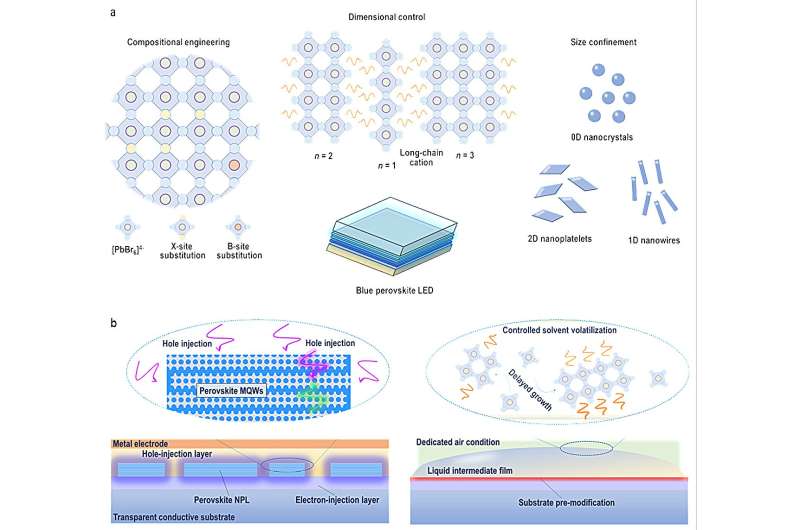This article has been reviewed according to Science X's editorial process and policies. Editors have highlighted the following attributes while ensuring the content's credibility:
fact-checked
peer-reviewed publication
trusted source
proofread
Focus on perovskite emitters in blue light–emitting diodes

In recent years, the advancement of LEDs based on perovskite materials has progressed significantly. The benefits of perovskite materials, including their straightforward production processes, wide color gamut, high color purity, and low cost, have facilitated the development of efficient red and green PeLED devices, which currently surpass 25% in efficiency. Consequently, PeLEDs have become one of the most promising next-generation display technologies.
However, the successful realization of this new display technology relies on the ability of red, green, and blue (RGB) LEDs to meet the required performance standards. Nonetheless, compared to red and green PeLEDs (R and G), blue PeLEDs (B) have exhibited sluggish progress. The efficiency of blue PeLED devices satisfying display requirements remains a mere 10%, far below that of their red and green counterparts. Furthermore, the stability of blue PeLED devices is insufficient, hindering the practical application of new PeLED technology in the display industry.
In a new paper published in Light: Science & Applications, a team of scientists, led by Dr. Xiaoyu Yang, Prof. Xinqiang Wang, and Mr. Changjun Lu from Leyard Optoelectronic Co., Ltd, China, School of Physics, Peking University, China, and co-workers have comprehensively summarized three main technical routes (compositional engineering, dimensional control, size confinement) towards blue perovskites and the latest progress of blue PeLED.
By employing compositional engineering on perovskites with ABX3 crystal structures, the element or molecular composition, and ratio of A, B, and X sites can be finely tuned. This adjustment results in an effective widening of the bandgap by manipulating the valence and conduction bands in the band structure, thereby enabling blue emission.
The quasi-2D, 2D, and 1D crystal structures of perovskites can be attained by substituting small cations at the A-site with larger long-chain cations. By utilizing the quantum confined domain effect, the bandgap of perovskite materials can be effectively widened. In addition, a cascade of energy phenomena arises within low-dimensional perovskite emitting layers featuring mixed n-values. Therefore, controlling the distribution and content of n-values in low-dimensional perovskites is critical.
Reducing perovskite materials to the nanoscale (i.e., perovskite nanocrystals) is another promising approach to realizing blue light emission. The surface ligands required for the synthesis of nanocrystals are crucial factors influencing their size, yield, and quality. Therefore, the development and optimization of surface ligands with high adaptability represent a vital technical direction for achieving blue light emission and enhancing device efficiency.
"Based on the understanding of the blue perovskites and related PeLED devices, we proposed the future ideal structure of the blue perovskite active layer, blue PeLED device configuration, and the processing methods. We considered that the in-situ growth of low-dimensional perovskite nanoplatelet structures by the Synthesis-on-Substrate method will enhance the probability of carrier radiation recombination and increase the hole injection area, achieving a breakthrough in the efficiency of blue PeLED devices," said Xiaoyu Yang.
"Blue PeLED devices with pure-blue emission at ~465 nm still lag far behind their green and red counterparts for display applications, and high-quality perovskite blue emitters are believed to be the foremost part that demands more effort on it. We believe that this work will give detailed guidance for the future development of blue perovskite emitters and gives inspiration to the candidate for all-perovskite displays throughout the LED community," the scientists say.
More information: Xiaoyu Yang et al, Focus on perovskite emitters in blue light-emitting diodes, Light: Science & Applications (2023). DOI: 10.1038/s41377-023-01206-2
Journal information: Light: Science & Applications
Provided by Chinese Academy of Sciences



















